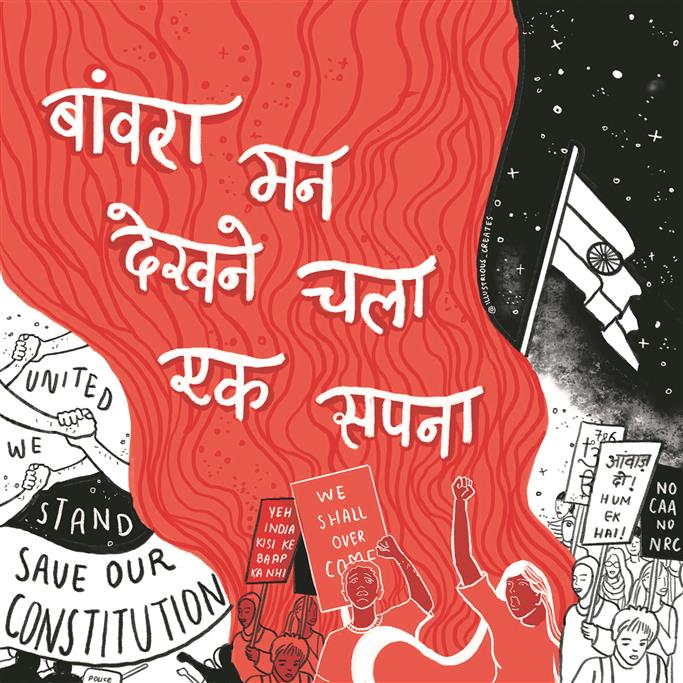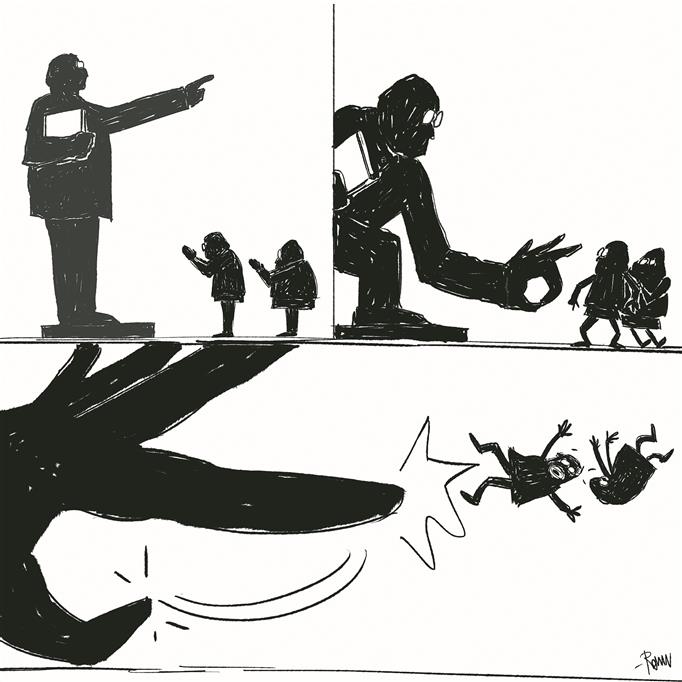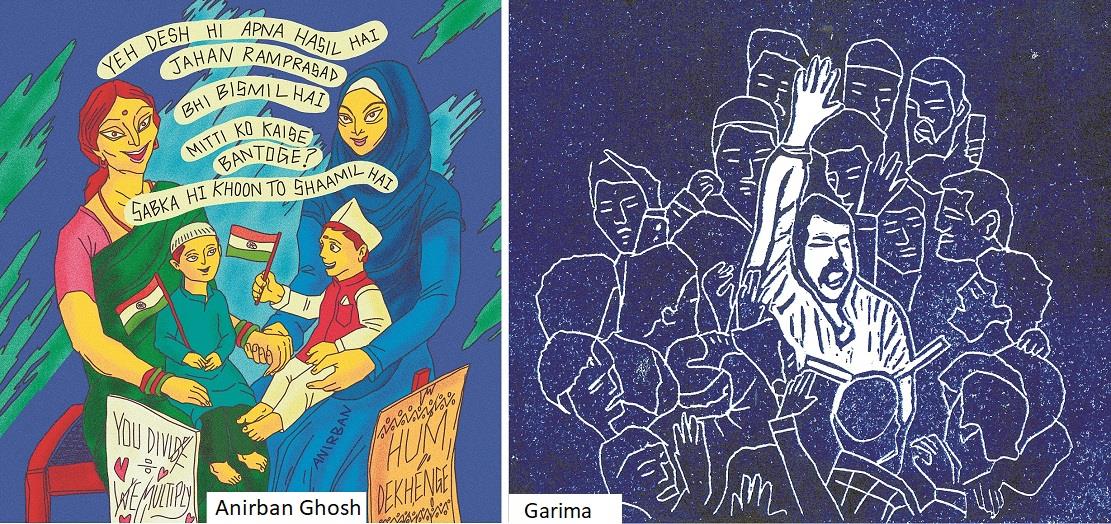
Arushi Chaudhary
Tear gas shells, water cannons, laathis and bullets were hurled by the Delhi Police to ‘rein in’ protestors around the Jamia Millia Islamia University campus on December 15, 2019. Images of students facing police brutality and then being marched with their hands in the air travelled far and wide and found their way to the mobile feed of Anirban Ghosh who was travelling outside the country at that time. A UX designer by profession and an illustrator by passion, 32-year-old Anirban found himself gripped by an unsettling angst. As an artist who has been focussing on women’s rights, human rights and LGBTQ rights since his student days, he craved a creative outlet to that anguish.

With an upbringing steeped in communal harmony — he recounts a time in 1990 when his parents dressed him up as a Muslim boy for a fancy dress competition in school to counter the narrative of communal divide being stoked by the Ram Rath Yatra, the response was natural. “I remember feeling increasingly restless. Upon returning to India, I went to Shaheen Bagh and the atmosphere there — the coming together of people from different backgrounds, women spearheading an entire movement and complete adherence to non-violence — gave me that final push to vocalise my stance against the divisive politics plaguing our country for the past six years through art,” Anirban says.

He created an artwork as an ode to the women of Shaheen Bagh, which has since gone viral. While he was still in Delhi, some students from Jamia approached him, seeking permission to recreate this artwork as a wall painting outside the campus. “So, I went and created the outline for the artwork for them, leaving them to fill it up with their imagination,” he adds. Anirban has since created many different illustrations depicting landmark moments in this movement of resistance, including a portrait of JNUSU president Aishe Ghosh with bandaged head after being assaulted on campus. He is also working on a series inspired by comedian and lyricist Varun Grover’s ‘Hum Kaagaz Nahi Dikhayenge’, which has become an anthem of sorts for these protests.

Rohan Chakravarty, a 32-year-old wildlife and environment conservation cartoonist who has been contributing to leading national newspapers and publications since 2010, also felt the need to go beyond his love for the environment and take a political stance through his art. “I have been making illustrations targeting government policies on wildlife and environment, irrespective of the regime in power,” says Chakravarty, who decided to expand the scope of his work in the present times where “staying silent is no longer an option.”
Of course, sticking one’s neck out in these times when voices of dissent are stifled through different mechanism — heavy, organised online trolling being the most rampant tool — isn’t easy. It is not just political expressions that land in the eye of a trolling storm. For Chakravarty, even a comic strip satirising PM Modi’s interview with Bear Grylls invited a fair amount of backlash. “It’s clear that the present atmosphere is not conducive to criticism and there is no scope of those on the other side of the divide understanding art as an expression of dissent, so one can never be too careful in these times. I’m already exploring my options in terms of legal aid and support, just in case there is a government crackdown on those voicing their opinion against these policies.”
The idea of political art being a cry for help is resonating with more and more young minds. One such example is 21-year-old student Lamya Mohsin Khan, a self-taught and upcoming artist, for whom this entire CAA-NRC debate hits home. Undeterred by consequences and her family sounding notes of caution, Lamya continues to voice her disagreement with the government’s policies on the citizenship legislation and the impending NRC on social media platforms. Out of the blue, she found herself in the thick of a trolling storm. She didn’t know how to deal with when her illustration with a swastika on the Indian flag and the Parliament was shared by journalist Rana Ayyub. “As a young Muslim woman, this atmosphere of hate isn’t new to me. It is something that I have grown up with and this latent fear has been palpable since the Gujarat riots of 2002. In fact, with people from different backgrounds, religions, communities standing in solidarity with the Muslims of India, it is for the first time that we don’t feel the fear as much.” Besides using her craft to voice her dissent, Lamya and the women in her family continue to participate in the protest at Shaheen Bagh, drawing strength from the hope that their voice will be heard.
Danish Shaikh, a 26-year-old who runs his own graphic design firm, also talks about the palpable fear the CAA-NRC combination is stirring up for people like him. He recounts his family having a detailed discussion over breakfast on the identity documents they have in place and if that’d be enough to prove their citizenship. In times where legitimacy of one’s citizenship has become casual dining table conversation, using their skill to contribute to this space where art meets dissent comes naturally to artists like Danish. “The power of art is rendered useless unless it is used to portray things that people aren’t comfortable facing or talking about and that includes standing up to oppressive authorities,” he says.
Speaking of online trolling and backlash, he cheekily says, “The trolling is so rampant these days that if you don’t receive hate online, you start questioning the quality of your work.”
He started adding political commentary to his body of work with a series called Achhe Din, which was a satirical take on the BJP’s 2014 poll promise, but has become more proactive in the space since the anti-CAA-NRC stir began to take hold. “The fact that government is no longer even trying to hide its divisive agenda has been the driving force for me. Being from a minority community that is being openly targeted, this hits too close to home,” he says.
Priyanka Gogoi, a cartoonist from Assam — a state that has resisted this legislation the hardest — believes that to create art on a subject of society is to hold a mirror to the audience. In times of unrest, the art that the artist creates has to be in tune with the frustration that society feels. She says her illustrations on CAA-NRC were not made with the conscious intention of portraying dissent. She was hurting and disturbed, and those emotions just came through in the art she created. “It’s another matter that my voice resonated with many others,” Priyanaka says.
As a student of law with an artistic streak, Priyanka feels she’s in a unique position to dispel many myths and inaccuracies surrounding these developments, especially in context of Assam. “There have been conversations shrouded with legal technicalities, the Constitution, NRC-CAA along with the Assam Accord, arrests under UAPA. I’m in a unique position to use cartoons to simplify the legal technicalities and present them with a (hopefully) funny twist.”
Besides individual artists, social media handles that act as aggregator of art from contributors across the country are also springing up.
Ozin Patoki – Artists Against Facism is one such Instagram handle. Set up by three independent artists from Assam, the page is a collective platform for contributors from all over the country. The account was created during the internet shutdown in Assam. These artists, naturally, felt that being cut off from the rest of country and the world not only resulted in an information void but also stifled their voices. One of the three founding members of this page still had internet access during that period. So, the others would meet this person and pass on images and illustrations to be shared online and Ozin Patoki came into being. Eventually, they started inviting artists from across the country to contribute and also gave them the option of anonymity.
Speaking of art to bolster the hum against CAA-NRC, the artists who chose to remain anonymous, say, “Art is what comes naturally to us when we want to express something. The times call for dissent and we are merely putting to use the resources best available to us. Art has played an indispensable role in protest movements throughout history. It captures the imagination of the masses and adds the much-needed fuel to the fire.
Another page of similar character goes by the name of Art of Resistance. Choosing to remain anonymous, the people behind this Instagram handle say, “Art doesn’t start movements of dissent; it helps articulate them. If people are dissenting, then art will reflect that as well. Our page is a collection of art made as resistance. India is the largest democracy in the world and is currently in the midst of a people’s movement. We are documenting it by collecting art from the movement and putting it at one place. Our focus right now is India because a movement like this in a democracy is so significant. If tomorrow a huge people’s movement starts in another part of the world, we could shift our focus there too.”
Most of these artists are sharing their works on social media platforms like Instagram and Twitter, with a free-for-all offer for anyone to print and use these as their own expression of dissent.
Join Whatsapp Channel of The Tribune for latest updates.



























